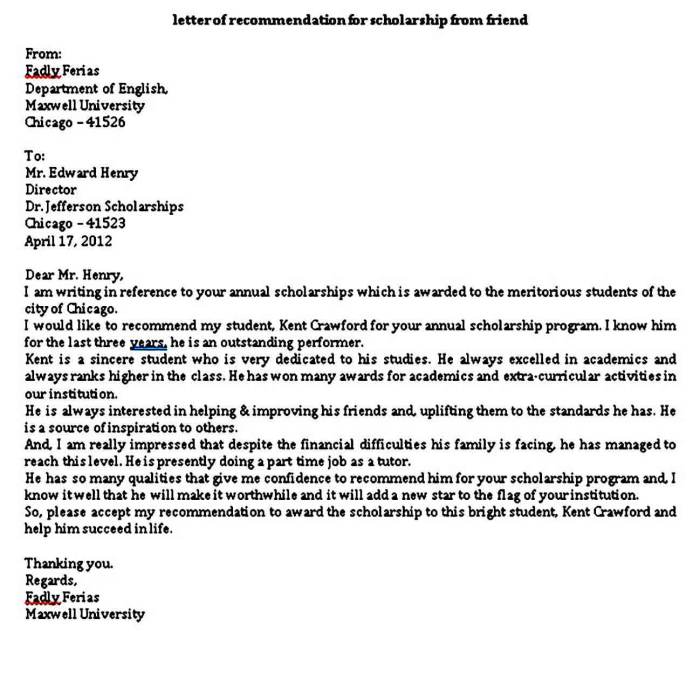Attention, scholarship seekers! Dive into our comprehensive guide to crafting a winning letter of intent sample scholarship that will make you stand out from the crowd. Let's unlock the secrets of writing a compelling letter that showcases your aspirations and qualifications.
In this guide, we'll delve into the essential components of a strong letter of intent, common pitfalls to avoid, and formatting and style considerations. We'll also showcase successful examples and provide insights into what makes them shine.
Sample Letter of Intent for Scholarship Applications: Letter Of Intent Sample Scholarship
In the realm of scholarship applications, a letter of intent emerges as a crucial document that articulates an applicant's aspirations, qualifications, and motivation for pursuing a particular scholarship opportunity. It serves as a compelling introduction, highlighting the applicant's potential and aligning their goals with the scholarship's objectives.
Crafting a well-structured letter of intent requires careful consideration of its components and adherence to established conventions. A typical letter of intent includes the following elements:
Letter of Intent Template
- Formal Heading: Begin with your name, address, and contact information, followed by the date and recipient's details.
- Introduction: Start with a strong hook that captures the reader's attention and succinctly states your purpose for writing.
- Scholarship Details: Specify the scholarship you are applying for and briefly mention its key criteria.
- Qualifications and Accomplishments: Highlight your relevant skills, experiences, and academic achievements that align with the scholarship's requirements.
- Aspirations and Goals: Explain how the scholarship aligns with your long-term career and academic aspirations.
- Closing Statement: Conclude by reiterating your interest in the scholarship and expressing your gratitude for the opportunity to be considered.
Tips for Crafting a Compelling Letter
- Be Specific and Concise: Provide specific examples and quantifiable data to support your claims.
- Tailor to the Scholarship: Research the scholarship thoroughly and tailor your letter to its specific requirements.
- Demonstrate Enthusiasm: Convey your genuine interest in the scholarship and explain why you are the ideal candidate.
- Proofread Carefully: Ensure your letter is free of grammatical errors and typos.
- Seek Feedback: Ask a mentor, teacher, or trusted friend to review your letter and provide constructive feedback.
Key Elements of a Strong Letter of Intent
Crafting a compelling letter of intent is crucial for scholarship applications. To succeed, applicants should meticulously incorporate key elements that highlight their aspirations, qualifications, and alignment with the scholarship's criteria.
A strong letter of intent typically includes the following essential components:
Clearly Stated Career Goals and Aspirations
Articulate your career objectives and aspirations clearly and concisely. Explain how the scholarship aligns with your long-term goals and how it will contribute to your professional development.
Specific Reasons for Applying to the Particular Scholarship Program
Research the scholarship program thoroughly and identify the specific aspects that make it a suitable match for your aspirations. Highlight how the scholarship's objectives align with your own and explain why you believe you are a suitable candidate.
Demonstrated Alignment between the Applicant's Qualifications and the Scholarship Criteria
Showcase how your academic achievements, extracurricular involvement, and personal qualities meet the eligibility criteria for the scholarship. Provide specific examples and evidence to support your claims.
Evidence of Academic Excellence and Extracurricular Involvement
Highlight your academic achievements, including your GPA, coursework, and research experience. Additionally, discuss your extracurricular activities and leadership roles to demonstrate your well-roundedness and commitment to personal growth.
Common Mistakes to Avoid in a Letter of Intent

To craft a compelling letter of intent, it's crucial to steer clear of common pitfalls that can weaken its impact. Here are some crucial mistakes to avoid:
Generic and Unfocused Language
Avoid using vague and generic language that fails to highlight your unique qualities or specific interest in the scholarship. Instead, tailor your letter to the specific scholarship and demonstrate how your goals align with its objectives.
Lack of Specificity or Detail
Don't simply restate information from your resume or transcript. Provide concrete examples and specific details that showcase your achievements, skills, and aspirations. Quantify your accomplishments whenever possible.
Grammatical Errors or Poor Writing Style
Proofread your letter carefully for any grammatical errors, typos, or inconsistencies. Poor writing can distract the reader and undermine the credibility of your application.
Inappropriate Tone or Language
Maintain a professional and respectful tone throughout your letter. Avoid using slang, informal language, or excessive flattery. Be concise, clear, and direct in your communication.
Formatting and Style Considerations
The formatting and style of your letter of intent play a crucial role in creating a professional and impactful document. Here are some guidelines to help you achieve a polished and effective letter:
Font and Layout
Choose a professional and legible font, such as Times New Roman, Arial, or Calibri. Use a font size of 12 or 14 points and maintain consistent margins throughout the letter.
Spacing and Indentation
Proper spacing and indentation enhance readability. Use single line spacing for the body of the letter and double line spacing for paragraphs. Indent the first line of each paragraph to create visual separation.
Salutation and Closing
Begin your letter with a formal salutation, such as "Dear [Scholarship Committee Name]." End the letter with a closing remark, such as "Sincerely," followed by your typed name and signature.
Word Count Limits
Most scholarship applications have specific word count limits. Adhere to these limits to ensure your letter is concise and focused on the most relevant information.
Examples and Case Studies
Examining successful letters of intent that have garnered scholarships can provide valuable insights into effective writing techniques and strategies. By analyzing their strengths and weaknesses, we can identify commonalities that contribute to their success.
Example 1, Letter of intent sample scholarship
This letter effectively conveys the applicant's passion for their field of study, highlighting their academic achievements and research experience. The writer clearly articulates their goals and how the scholarship would support their aspirations. The letter is well-written and error-free, demonstrating attention to detail.
Example 2
While this letter showcases the applicant's accomplishments, it lacks a clear connection to the scholarship's objectives. The writer fails to explain how their research aligns with the funder's priorities, making it difficult for the selection committee to assess their suitability for the award.
Commonalities among Successful Letters
- Clear and concise writing
- Strong evidence of academic excellence and potential
- Alignment with the scholarship's goals and objectives
- Articulation of a compelling vision for the future
- Attention to detail and error-free presentation
Outcome Summary
Remember, a well-crafted letter of intent sample scholarship is your golden ticket to scholarship success. By following our expert guidance, you'll create a letter that not only meets the criteria but also captivates the scholarship committee. So, let's get started on your journey to scholarship glory!
FAQs
What is the purpose of a letter of intent for scholarship applications?
A letter of intent is a formal document that expresses your interest in a particular scholarship program and Artikels your qualifications and aspirations. It's an opportunity to showcase why you're the ideal candidate and why you deserve to be awarded the scholarship.
What are the key elements of a strong letter of intent?
A strong letter of intent should clearly state your career goals, explain why you're applying to the specific scholarship program, demonstrate how your qualifications align with the scholarship criteria, and provide evidence of your academic excellence and extracurricular involvement.
What are some common mistakes to avoid in a letter of intent?
Common pitfalls to avoid include using generic language, lacking specificity, making grammatical errors, using an inappropriate tone, and exceeding the word count limit.





